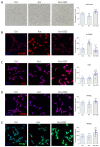Chemical Profiling of Polyphenolic Fraction of Cannabis sativa L. vr. Kompolti Industrial Inflorescences: Insights into Cannabidiol Neuroprotective Effects in a Cellular Model of Parkinson's Disease
- PMID: 40431038
- PMCID: PMC12115228
- DOI: 10.3390/plants14101473
Chemical Profiling of Polyphenolic Fraction of Cannabis sativa L. vr. Kompolti Industrial Inflorescences: Insights into Cannabidiol Neuroprotective Effects in a Cellular Model of Parkinson's Disease
Abstract
The ultra-high-performance liquid chromatography high-resolution mass spectrometry (LC-ESI-HR-MS/MS) technique was used to characterize the polyphenolic fraction of the hot water infusion (WI) of inflorescences of Cannabis sativa L. Kompolti variety, commercially used for food preparations or cosmetic purposes. On water infusion extract, we applied a multidisciplinary approach, where NMR, MS, in vitro cell-free and cell-based assays coupled with in silico studies, were used to rationalize at the molecular level the effects of the major component Cannabidiol (CBD), in a model of Parkinson's disease (PD). The phytochemical analysis by LC-MS/MS led to the tentative identification of many components belonging to different classes of polyphenols, such as phenolic acids, flavonoids, and their glycosides. CBD and cannabidiolic acid (CBDA) were also detected in good amounts in the infusion, together with several minor cannabinoids. In addition, the water infusion WI was evaluated for mineral content, total phenolic content, flavonoid content, and antioxidant capacity by DPPH and FRAP methods. Notably, our results in a cellular model of PD highlight that CBD protects against rotenone-induced cell death without recovering neuronal morphology. These biological outcomes were rationalized by an in silico approach, where we hypothesize that CBD could influence the cellular response to oxidative stress via its interaction with the Keap1/Nrf2 pathway. In summary, these results enriched the nutraceutical profile of the water infusion of the inflorescences of the Kompolti cultivar, which demonstrated a high CBD content. This study could lead to the development of dietary supplements that could help in the management of clinical symptoms related to the antioxidant activity of CBD in the pathophysiology of PD, which remains poorly characterized.
Keywords: Cannabis sativa L. vr. Kompolti; LC-MS/MS; Parkinson’s disease (PD); antioxidant effect; cannabinoids; minerals; molecular docking; nutraceuticals; phytochemicals; polyphenols.
Conflict of interest statement
Author Federico Trombetta was employed by the company Societa Cooperativa Agricola MarcheSana. The remaining authors declare that the research was conducted in the absence of any commercial or financial relationships that could be construed as a potential conflict of interest.
Figures






Similar articles
-
Chemical Characterization of Leaves, Male and Female Flowers from Spontaneous Cannabis (Cannabis sativa L.) Growing in Hungary.Chem Biodivers. 2019 Mar;16(3):e1800562. doi: 10.1002/cbdv.201800562. Epub 2019 Feb 12. Chem Biodivers. 2019. PMID: 30548994
-
New Methods for the Comprehensive Analysis of Bioactive Compounds in Cannabis sativa L. (hemp).Molecules. 2018 Oct 14;23(10):2639. doi: 10.3390/molecules23102639. Molecules. 2018. PMID: 30322208 Free PMC article.
-
Isolation, Purification, and Antimicrobial Characterization of Cannabidiolic Acid and Cannabidiol from Cannabis sativa L.Biomolecules. 2020 Jun 12;10(6):900. doi: 10.3390/biom10060900. Biomolecules. 2020. PMID: 32545687 Free PMC article.
-
Cannabis sativa L. and Nonpsychoactive Cannabinoids: Their Chemistry and Role against Oxidative Stress, Inflammation, and Cancer.Biomed Res Int. 2018 Dec 4;2018:1691428. doi: 10.1155/2018/1691428. eCollection 2018. Biomed Res Int. 2018. PMID: 30627539 Free PMC article. Review.
-
A Nrf-2 Stimulatory Hydroxylated Cannabidiol Derivative from Hemp (Cannabis sativa).J Nat Prod. 2022 Apr 22;85(4):1089-1097. doi: 10.1021/acs.jnatprod.1c01198. Epub 2022 Mar 22. J Nat Prod. 2022. PMID: 35316044 Free PMC article. Review.
References
-
- Dash U.C., Bhol N.K., Swain S.K., Samal R.R., Nayak P.K., Raina V., Panda S.K., Kerry R.G., Duttaroy A.K., Jena A.B. Oxidative stress and inflammation in the pathogenesis of neurological disorders: Mechanisms and implications. Acta Pharm. Sin. B. 2025;15:15–34. doi: 10.1016/j.apsb.2024.10.004. - DOI - PMC - PubMed
-
- Gąssowska-Dobrowolska M., Chlubek M., Kolasa A., Tomasiak P., Korbecki J., Skowrońska K., Tarnowski M., Masztalewicz M., Baranowska-Bosiacka I. Microglia and Astroglia—The Potential Role in Neuroinflammation Induced by Pre- and Neonatal Exposure to Lead (Pb) Int. J. Mol. Sci. 2023;24:9903. doi: 10.3390/ijms24129903. - DOI - PMC - PubMed
Grants and funding
LinkOut - more resources
Full Text Sources
Miscellaneous

